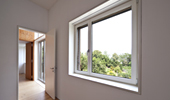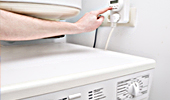
HUD USER Home > Energy-Efficient and Healthy Homes > Energy Efficiency and Indoor Air Quality
Energy Efficiency & Indoor Air Quality
 Property owners can improve a home’s energy performance and indoor air quality through various strategies. Insulation and air sealing are the most effective ways to improve a home’s energy efficiency. Nevertheless, adequate ventilation is important to minimize indoor pollutants, which can also be controlled with air cleaners. Controlling moisture and preventing mold growth are also essential to maintain indoor air quality. Finally, new fixtures, heating and air conditioning systems, and appliances can improve energy efficiency.
Property owners can improve a home’s energy performance and indoor air quality through various strategies. Insulation and air sealing are the most effective ways to improve a home’s energy efficiency. Nevertheless, adequate ventilation is important to minimize indoor pollutants, which can also be controlled with air cleaners. Controlling moisture and preventing mold growth are also essential to maintain indoor air quality. Finally, new fixtures, heating and air conditioning systems, and appliances can improve energy efficiency.
Insulation and Air Sealing
 The U.S. Environmental Protection Agency (EPA) estimates that proper insulating and air sealing measures can save homeowners up to 20 percent of their heating and cooling costs or up to 10 percent of their total energy costs. Read More >>
The U.S. Environmental Protection Agency (EPA) estimates that proper insulating and air sealing measures can save homeowners up to 20 percent of their heating and cooling costs or up to 10 percent of their total energy costs. Read More >>
Indoor Air Quality
 Maintaining good indoor air quality is critical for the health and comfort of a home’s occupants. Most air quality problems in homes originate from indoor sources of gases or particles that cause health problems at high concentrations. Inadequate ventilation, high temperatures, and high humidity levels can also increase the concentration of indoor air pollutants. Read More >>
Maintaining good indoor air quality is critical for the health and comfort of a home’s occupants. Most air quality problems in homes originate from indoor sources of gases or particles that cause health problems at high concentrations. Inadequate ventilation, high temperatures, and high humidity levels can also increase the concentration of indoor air pollutants. Read More >>
Resource- and Energy-Efficient Fixtures and Appliances
 This section provides information on energy-efficient products for homes, including windows, skylights, and doors; heating and cooling systems; water heating systems; water-efficient fixtures; appliances and electronics; and light bulbs. ENERGY STAR qualified products meet strict energy-efficiency guidelines set by the U.S. Environmental Protection Agency and the U.S. Department of Energy (DOE). Although ENERGY STAR qualified products might cost more than conventional models, they consume less energy and save money over their lifespan. DOE’s website provides information on calculators that allow users to estimate the energy and cost savings accrued by using energy-efficient products.
Read More >>
This section provides information on energy-efficient products for homes, including windows, skylights, and doors; heating and cooling systems; water heating systems; water-efficient fixtures; appliances and electronics; and light bulbs. ENERGY STAR qualified products meet strict energy-efficiency guidelines set by the U.S. Environmental Protection Agency and the U.S. Department of Energy (DOE). Although ENERGY STAR qualified products might cost more than conventional models, they consume less energy and save money over their lifespan. DOE’s website provides information on calculators that allow users to estimate the energy and cost savings accrued by using energy-efficient products.
Read More >>
